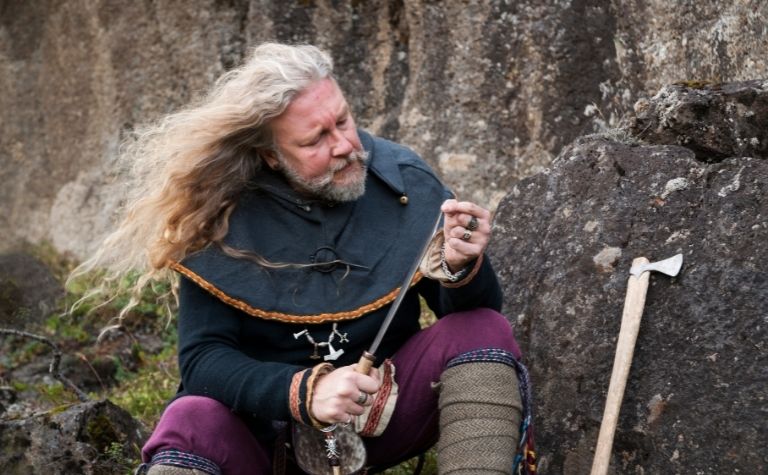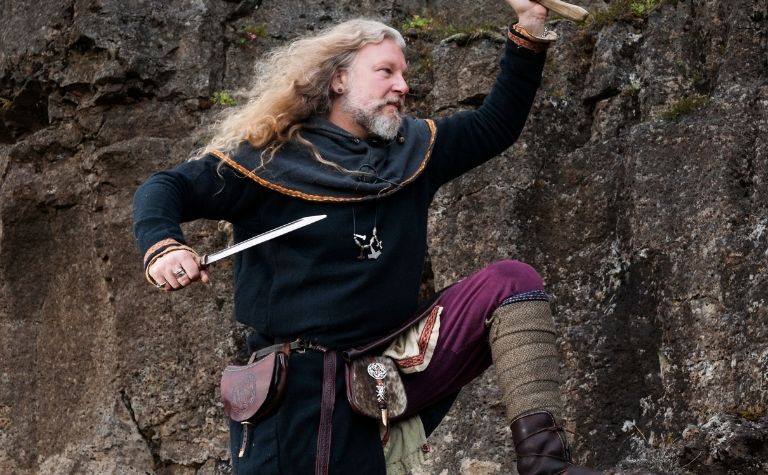The Vikings used all sorts of weapons, from swords to spears to axes to bows. One of the lesser-known Viking weapons is the seax, a kind of knife or shortsword.
Knives like the seax would have been useful for combat as well as everyday chores.
The seax (also called a sax or sex) was a long iron knife with a single blade.
The blades were often grooved, and some were inlaid with precious metals or inscribed with runes.
Archeologists have found Viking Age seaxes all over Europe. They were not unique to the Vikings and were popular in European countries outside of Scandinavia, too.
This article will take a closer look at the seax and answer four common questions about this ancient weapon.
Also see What Kind of Bows Did the Vikings Have? to learn more.

What Is the Purpose of a Seax?
Knives held several uses for the Vikings. From hunting for food to dressing an animal, from cutting ropes to fighting in close combat, the Vikings relied on knives for all kinds of tasks.
Some knives were strictly for one kind of task (for example, hunting), while others were multipurpose.
The seax was mainly used for hunting and fighting.
The blade was long and heavy enough to be larger than a traditional dagger but small enough to still be wielded with one hand.
Most Viking warriors probably carried a seax in addition to their other weapons. The seax was a sidearm, a backup on the battlefield if one’s axe or sword broke.
Seaxes were also useful when an enemy moved so close that ranged weapons like a spear or bow were useless.
If a target wore heavy armor, the weight of a blow from a seax could still cause severe internal injury. If a Viking’s opponent were unarmored, a seax strike could be lethal.
Vikings often wore their seaxes upright in the sheath on their belts. [1]
This allowed them to draw their blades and attack in a single motion instead of turning the dagger to strike.
Off the battlefield, the Vikings used seaxes for hacking rather than fine, detailed work.
Seaxes were thick and heavy compared to other knives, making them unsuitable for delicate strokes.
Seaxes may have begun as hunting or farm tools and later evolved into combat weapons.
Also see Did the Vikings Have Slaves? to learn more.

What Does a Seax Knife Look Like?
Seax knives vary wildly in size. While most were used like long daggers, some seaxes were long enough to be called shortswords.
The most consistent feature of seaxes is the single blade that gently tapers to a point.
A seax knife is long, at least 10 inches (25.4 centimeters), often longer.
Only one side of the blade is sharpened, and the blunt end is thick and heavy.
Some seaxes were decorated with runic inscriptions or metal inlays.
Knife handles were made from organic material like wood or bone.
After a millennium, the handles have degraded, leaving only the knife blade.
If someone were to see a seax knife in a museum, they would notice its long tang, the metal end of the knife that was attached to the handle.
The tang is wedged inside the handle, holding the blade together.
Seaxes did not require much skill for a blacksmith to forge.
Undecorated seaxes were easy for most to produce, so the majority of Vikings had access to them.
But a few surviving seaxes were crafted with precision and care, inlaid with precious metals, and decorated with artwork.
Perhaps the most famous Viking seax is called the Seax of Beagnoth, displayed at the British Museum. [2]
This seax has a blade almost two feet (61 centimeters) long. It is intricately decorated with silver, brass, and copper inlaid in geometric patterns.
It is also engraved with a 28-letter runic alphabet and an Old English name, possibly the maker or wielder of the blade.
The Seax of Beagnoth is the only seax with a full runic alphabet found in England, though others have been uncovered in Scandinavia.
Scholars speculate why the Vikings and Anglo-Saxons wrote alphabets on their blades. Maybe it was for protection, as a form of superstition.
The decorative patterns on seaxes vary from long, simple grooves (seen in the seax on display at the Museum of London) to tiny illustrations (found on another seax at the British Museum). [3]
The blacksmith did not appear to decorate the sharp part of the blade.
Instead, he carved out small panels on the dull, thicker side. He filled those panels with patterns, text, or pictures.
Also see What Language Did the Vikings Speak? to learn more.
Seax vs. Scramasax: What’s the Difference?
The word “seax” comes from the Old English word for “knife.” Now “seax” refers specifically to Viking or Anglo-Saxon knives with a long, side-edged blade.
But the root appears in other names, such as the:
- Hadseax
- Langseax
- Scramasax
Seaxes and scramasaxes are the same. The terms are used interchangeably, and there does not appear to be any meaningful difference between the two.
They both refer to long Anglo-Saxon knives with a single edge.
The Museum of London refers to the same single-edged blade as both a seax and scramasax.
The Merriam-Webster entry for “scramasax” describes a large Anglo-Saxon knife used for hunting and combat, the same thing as a seax.
However, the terms “hadseax” and “langseax” do appear to be distinct from “seax.” A hadseax is a small seax, used more for household work than for combat.
A langseax is the term for a seax long enough to be considered a shortsword.
Seax vs. a Dagger: What’s the Difference?
Games like Assassin’s Creed have helped bring the seax out of obscurity.
But there is some confusion about the classification of seaxes–are they the same as daggers, or do they have their own category?
A seax is actually a type of dagger. They are simple, long-bladed daggers with just one sharp edge. All seaxes are daggers, but not all daggers are seaxes.
A dagger is any knife meant for stabbing, a bladed weapon shorter than a sword.
Most seaxes are larger than the average dagger, but they are still smaller than swords and, therefore, still daggers. [4]
The Vikings used their seaxes for close-combat attacks and as a stealthy sidearm, much like people worldwide have used daggers.
Conclusion
A Viking’s seax was his hidden, secret weapon. It was versatile, accessible, and, most of all, deadly.
